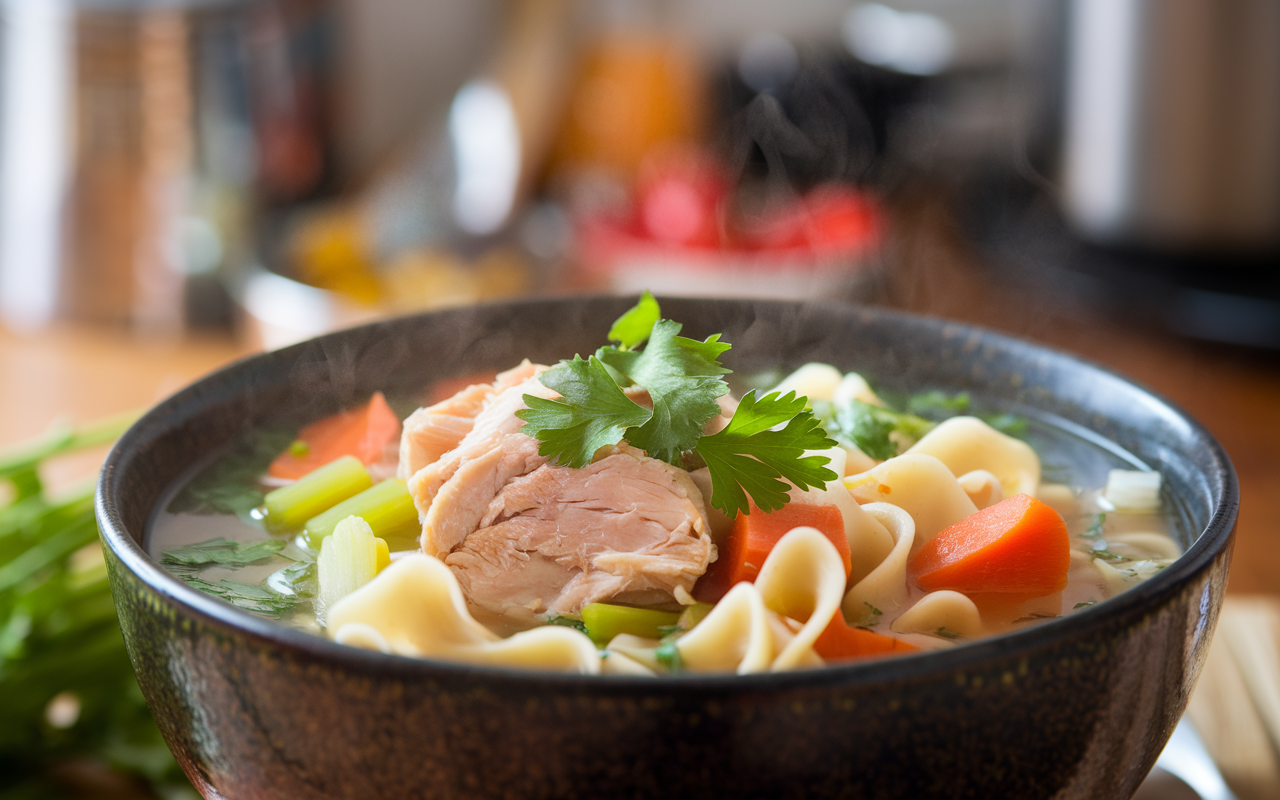If you’re craving a warm, comforting dish that satisfies your taste buds and nourishes your body, look no further than gluten free chicken noodle soup. This classic soup has been a favorite for generations, offering a delicious blend of savory chicken, hearty vegetables, and perfectly seasoned broth. The twist? It’s entirely gluten-free, making it suitable for those with dietary restrictions or anyone looking to enjoy a wholesome meal.
Whether you’re battling a cold, need a quick weeknight dinner, or simply want a feel-good meal, gluten free chicken noodle soup is the answer. In this comprehensive guide, you’ll discover how to make the best version of this soup from scratch, tips on ingredient substitutions, and answers to common questions.
Why Choose Gluten Free Chicken Noodle Soup?
There are many reasons why gluten free chicken noodle soup should be part of your recipe collection. For starters, gluten-free diets are becoming increasingly common due to celiac disease, gluten sensitivity, or personal health choices. You may also want to incorporate this soup into your routine if you’re following an anti-inflammatory diet or just prefer the lighter feel of gluten-free meals.
Healthier for those with gluten sensitivities: By using gluten-free noodles and avoiding gluten-containing broths or seasonings, this soup provides a safe alternative for individuals with celiac disease or non-celiac gluten sensitivity.
Packed with nutrients: Chicken is an excellent source of protein, while vegetables like carrots, celery, and onions are rich in vitamins and minerals. Plus, the savory broth helps with hydration and recovery, making it a great option when you’re under the weather.
Versatile and customizable: You can adjust the ingredients to suit your taste or dietary needs, swapping out vegetables, noodles, or even the type of protein used.
The next time you’re feeling under the weather or want a comforting meal, gluten free chicken noodle soup will be the perfect choice.
Ingredients for Gluten Free Chicken Noodle Soup
Making a homemade gluten free chicken noodle soup is straightforward and requires only a few basic ingredients. Here’s what you’ll need:
Main Ingredients:
Chicken: Use boneless, skinless chicken breasts or thighs. For extra flavor, you can also use rotisserie chicken.
Gluten-free noodles: Look for gluten-free egg noodles or other gluten-free pasta varieties.
Vegetables: Carrots, celery, and onion are the traditional soup veggies. You can add others like peas or corn for a twist.
Chicken broth: Make sure to select a gluten-free broth. Some store-bought broths contain hidden gluten, so check the label carefully. You can also make your own by simmering chicken bones and vegetables in water.
Herbs and spices: Bay leaves, thyme, parsley, salt, and pepper are all you need to season the soup. You can also add garlic for extra flavor.
Optional Ingredients:
Lemon juice: A splash of lemon juice can help brighten the soup.
Fresh herbs: A handful of fresh parsley or dill adds a fresh, herbal touch.
Spinach: For a nutrient boost, toss in a handful of spinach in the last few minutes of cooking.
Step-by-Step Guide to Making Gluten Free Chicken Noodle Soup
Follow this simple recipe to create a rich, flavorful, and gluten free chicken noodle soup that will have your family asking for more.
Step 1: Prepare the Chicken
Start by cooking the chicken. If you’re using raw chicken breasts or thighs, you can either boil or roast them. To boil, place the chicken in a pot of water, add a pinch of salt, and simmer for 20-30 minutes until fully cooked. If you prefer roasting, season the chicken with salt, pepper, and your favorite herbs, then roast at 375°F (190°C) for about 25-30 minutes. Once cooked, shred the chicken into bite-sized pieces and set it aside.
Step 2: Sauté the Vegetables
In a large pot, heat a tablespoon of olive oil over medium heat. Add the chopped onions, carrots, and celery, sautéing them for 5-7 minutes, or until the vegetables are soft and fragrant. This step enhances the flavor of the soup by caramelizing the vegetables.
Step 3: Add Broth and Seasonings
Once the vegetables are soft, pour in the chicken broth and bring the mixture to a simmer. Add the bay leaves, thyme, salt, pepper, and any other seasonings you like. Let the soup simmer for 15 minutes to allow the flavors to meld together.
Step 4: Cook the Noodles
Add the gluten-free noodles to the pot and cook them according to the package instructions, which usually takes about 5-8 minutes. Be mindful that gluten-free noodles can sometimes become mushy if overcooked, so check the doneness frequently.
Step 5: Combine and Serve
Once the noodles are cooked, add the shredded chicken back into the soup. Stir to combine and heat the chicken through. Taste and adjust the seasoning with more salt, pepper, or herbs if necessary. If you like a bit of acidity, squeeze in some fresh lemon juice before serving.
Tips for the Best Gluten Free Chicken Noodle Soup
To make your gluten free chicken noodle soup even better, consider the following tips:
Use homemade broth: While store-bought gluten-free broth works, homemade broth is richer and more flavorful. Plus, it’s a great way to use leftover chicken bones.
Don’t overcook the noodles: Gluten-free noodles can become mushy quickly, so be sure to monitor them carefully. You can also cook the noodles separately and add them to the soup just before serving.
Add extra veggies: Add peas, corn, or spinach for extra nutrients and color.
Make it ahead: Gluten free chicken noodle soup tastes even better the next day as the flavors meld together. Store leftovers in an airtight container in the fridge for up to 3-4 days.
Frequently Asked Questions (FAQs)
Does chicken noodle soup contain gluten?
Traditional chicken noodle soup may contain gluten, as it typically uses wheat-based noodles. However, by using gluten-free noodles and checking the broth for gluten, you can make a delicious and safe gluten free chicken noodle soup.
What makes chicken broth not gluten free?
Not all chicken broths are gluten-free. For instance, some store-bought broths may contain wheat as a thickening agent or other gluten-based additives. Therefore, it’s important to always check the label before purchasing. Alternatively, you can make your own broth at home, which allows you to control the ingredients and ensure it’s entirely gluten-free.
Is Campbell’s chicken noodle soup gluten free?
Campbell’s Chicken Noodle Soup is not gluten-free, as it contains wheat-based noodles. However, if you’re looking for a gluten-free alternative, you can make your own soup using gluten-free noodles. Additionally, many other brands now offer certified gluten-free options, so be sure to check the label for those.
What packet soups are gluten free?
Several brands offer gluten-free packet soups. For example, Progresso, Pacific Foods, and Amy’s Kitchen all provide delicious gluten-free options. However, it’s always crucial to read the label before purchasing, as recipes and ingredients can change over time. Therefore, verifying the gluten-free certification is a good practice to ensure the soup meets your dietary needs.
Conclusion
In conclusion,chicken noodle soup is the perfect comfort food that caters to a wide range of dietary needs while delivering on flavor and nutrition. Whether you’re following a gluten-free diet or simply looking for a wholesome, satisfying meal, this soup is easy to make, versatile, and incredibly delicious. By using simple, healthy ingredients like chicken, vegetables, and gluten-free noodles, you can create a dish that’s both comforting and nourishing for any occasion.
Remember, making your own chicken noodle soup allows you to customize it to your liking—whether that means adjusting the seasoning, adding extra veggies, or experimenting with different types of gluten-free noodles. Plus, with the ability to make it ahead of time, you’ll always have a warm, hearty meal ready when you need it most.
So, next time you’re craving a bowl of comforting soup, skip the canned options and try this homemade version. It’s sure to become a family favorite, offering the perfect balance of flavors and textures in every spoonful.

